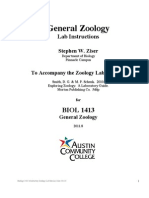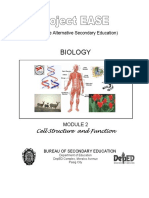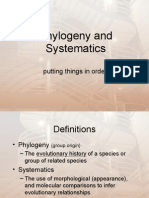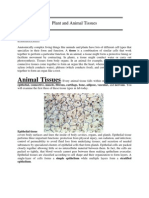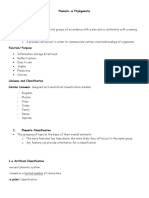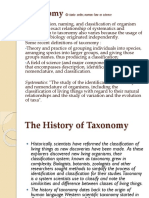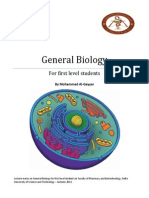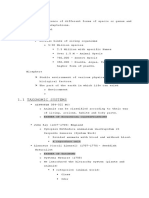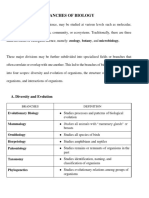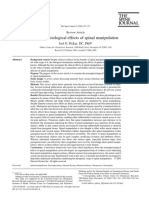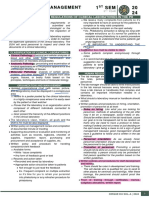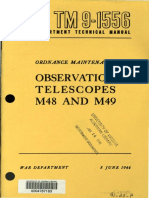Professional Documents
Culture Documents
Introduction To Zoology
Introduction To Zoology
Uploaded by
Ms. Wren100%(1)100% found this document useful (1 vote)
2K views7 pagesZoology is the study of animals and their interactions with ecosystems. It has several branches including structural zoology, which studies animal morphology, anatomy, histology and cytology; developmental zoology, which includes embryology; functional zoology, focusing on physiology and behavior; systematic zoology and taxonomy; and distributional zoology involving zoogeography and ecology. Zoologists specialize in specific areas like entomology, ichthyology, ornithology, and more. The history of zoology dates back to ancient civilizations, but it established as a modern science in the 17th-18th centuries.
Original Description:
Some basic information about Zoology are tackled in this topic.
Original Title
Introduction to Zoology
Copyright
© © All Rights Reserved
Available Formats
PDF, TXT or read online from Scribd
Share this document
Read this document in other languages
Did you find this document useful?
Is this content inappropriate?
Report this DocumentZoology is the study of animals and their interactions with ecosystems. It has several branches including structural zoology, which studies animal morphology, anatomy, histology and cytology; developmental zoology, which includes embryology; functional zoology, focusing on physiology and behavior; systematic zoology and taxonomy; and distributional zoology involving zoogeography and ecology. Zoologists specialize in specific areas like entomology, ichthyology, ornithology, and more. The history of zoology dates back to ancient civilizations, but it established as a modern science in the 17th-18th centuries.
Copyright:
© All Rights Reserved
Available Formats
Download as PDF, TXT or read online from Scribd
Download as pdf or txt
100%(1)100% found this document useful (1 vote)
2K views7 pagesIntroduction To Zoology
Introduction To Zoology
Uploaded by
Ms. WrenZoology is the study of animals and their interactions with ecosystems. It has several branches including structural zoology, which studies animal morphology, anatomy, histology and cytology; developmental zoology, which includes embryology; functional zoology, focusing on physiology and behavior; systematic zoology and taxonomy; and distributional zoology involving zoogeography and ecology. Zoologists specialize in specific areas like entomology, ichthyology, ornithology, and more. The history of zoology dates back to ancient civilizations, but it established as a modern science in the 17th-18th centuries.
Copyright:
© All Rights Reserved
Available Formats
Download as PDF, TXT or read online from Scribd
Download as pdf or txt
You are on page 1of 7
b.
Ontogeny - Study of individual
ZOOLEC SG1: (birth to death)
c. Genetics - Study of mechanisms of
Introduction to transmission of traits from parents to
offspring
Zoology III. Functional Zoology
Zoology (Gr. zoon, animal & logos, study) a. Animal Physiology - Study of the
> Study of animals life-supporting, properties, functions,
> It includes the interaction of animal and processes of animals or their
kingdom in their ecosystems such as parts
classification, habits, structure, embryology, b. Animal Behavior/Ethology - Study
distribution, evolution, and extinct species. of animal behavior, usually with a
focus on behaviour under natural
conditions, and viewing behaviour as
Branches of Zoology
an evolutionary adaptive trait
I. Structural Zoology
IV. Systematic/Taxonomy
a. Morphology - Study of size, shape,
a. Protozoology - Study of protozoa
and structure of animals, plants, and
b. Entomology - Study of insects
microorganisms, and of the
c. Conchology - Study of shells
relationships of their constituent
d. Malacology - Study of molluscs
parts.
e. Herpetology - Study of amphibians
b. Anatomy - Study of the structure of
and reptiles
the entire organisms and their parts.
f. Ornithology - Study of birds
c. Histology - Study of tissues
g. Ichthyology - Study of fishes
d. Cytology - Study of structure and
h. Helminthology - Study of worms
function of cells
V. Medical Zoology
II. Developmental Zoology
a. Parasitology - Study of parasites,
a. Embryology - Study of the
their hosts, and the relationship
development of an animal from the
between them
fertilized egg to birth or hatching
b. Pathology - Study of the causes and Zoology Disciplines
effects of disease or injury
● Comparative Anatomy - the study
VI. Distributional Zoology
of structures and functions of various
a. Zoogeography - deals with the
animal groups
geographical distribution of animals
● Taxonomy - the science of finding,
b. Ecology - (oikos,
describing, and classifying animals
house/environment),
● Entomology
interrelationship of living things and
● Ichthyology
non-living things
● Herpetology
VII. Historical Zoology
● Ethology
a. Paleontology - fossils and remains
● Malacology
of animals (extinct)
● Myrmecology - the study of ants
b. Phylogeny - origin of species
● Helminthology
c. Evolution - origin
VIII. Specialized Fields of Zoology
a. Molecular Zoology Examples of Specializations
-the structure and physiology of in Zoology
animals is studied under such fields
● Anatomy
as anatomy, embryology, pathology,
● Cytology
animal nutriology and physiology;
● Comparative Genomics and
- the common genetic and
Bioinformatics - study of the
developmental mechanisms of
structure, function, and evolution of
animals (and plants) is studied in
the genetic composition of groups of
molecular biology, molecular
animals using computer-based
genetics, cellular biology,
computational methods
biochemistry, and developmental
● Ecology
biology
● Embryology
● Genetics
● Histology
● Molecular Biology - study of ● Animal Rehabilitation
subcellular details of structure and ● Reproductive Biologist
function ● Fisheries Biologist
● Parasitology - study of animals that ● Animal Trainer
live in or on other organisms at the ● Veterinarian
expense of the host ● Geneticist
● Physiology - study of the function of ● Teacher
organisms and their parts
● Systematics - study of the History of Zoology
classification of, and the
● In ancient India, texts described
evolutionary interrrelationships
some aspects of bird life
among animal groups
● In Egypt, the metamorphosis of
insects and frogs was described
Examples of Specializations ● Egyptians and babylonians also
in Zoology by Taxonomic knew of anatomy and physiology in
various forms
Categories ● In ancient Mesopotamia, animals
● Entomology were sometimes kept in what can be
● Herpetology described as the first zoological
● Ichthyology gardens
● Mammalogy - study of mammals ● Aristotle described many animals
● Ornithology and their behaviours. He is the first
● Protozoology to devise a system of classifying
animals and is the “Father of
A Zoologist does the ff: Zoology”
● In ancient Rome, Pliny the leader
● Biochemist/Lab Technician
is known for his knowledge of
● Marine Biologist
nature, wrote a book “Natural
● Wildlife Researcher
History”
● Claudius Galen became a pioneer in ● Robert Hooke published
physiology, medicine, and anatomy Micrographia in 1665 based on his
● Hippocrates (Greece) is the “Father observations using a microscope
of Medicine” who devised the code single lens. Described the
of medical ethics. Establishment of compartments of cork tissue as
first biomedical tradition “cells”
● Leonardo da Vinci is an anatomist ● Anton Van Leeuwehoek
and scientist who made contribution (1632-1723) who made more than
by conducting autopsies on humans, 400 microscopes himself, was the
study the concept of homology first person to view single-celled
(similarity in embryonic origin and microbes
development)
● Andreas Vesalius is the first to The Growth of Modern
dissect cadavers and accurately
depict anatomy and is called the Zoology
“Father of Anatomy” ● In the 17th Century, adherents of the
● Conrad Von Gessner wrote the new philosophy of investigation of
book “Historia Animalium” which is nature by means of observation and
the basis of modern zoology experiment banded themselves into
● William Harvey made the 1st academies or societies for mutaul
accurate description of blood support and dialogue
circulation
● Marcello Malphighi is an 17th-18th Century
Anatomist and Entomologist who
● Systematizing and classifying
had such observations on blood
dominated biology
circulation, demonstration of
● Carolus Linnaeus (1707-1778), a
capillary circulation in the lungs of
Swedish botanist, developed a
Frosch
classification for animals based on
shared characteristics. He is the
Father of Taxonomy, one of the ● Have enormous variety of color
Father of Modern Ecology. Binomial patterns
System of Nomenclature ● Mouth brood their young
● George Cuvier is a French naturalist
and zoologist who established the A Scale-Eating Cichlid
fields of comparative anatomy and ● Perissodus Microlepis
paleontology ● Attack from behind as they feed on
scales of prey fish
19th Century ● Two body forms are maintained in
the population. One form is the
● In later part, the area of genetics
mouth is asymmetrically curved to
developed
the right and attack the prey’s left
● Gregor Mendel formulated his laws
side and vice versa for the second
of inheritance, published in 1866. He
form
is the “Father of Genetics”
● Endemic (found only in) to Lake
● Claude Bernard is a French
Tanganyika
physiologist and the Father of
Experimental Medicine
● In 1859, Charles Darwin published ZOOLOGY: An
The Origin of Species, by means of
Evolutionary Perspective
Natural Selection. Father & Theory
● Animals share a common
of Evolution
evolutionary past and evolutionary
forces that influenced their history
CICHLIDAE ● Evolutionary processes are
● One large family of bony fish remarkable for their relative
● Contains 2,000-3,000 species simplicity, yet they have had
● One of the members: Tilapia awesome effects on life-forms
● 2.5 cm to 1m
Evolutionary Processes of variation in a series of enzymes,
called allozymes, and DNA
Organic Evolution is change in the genetic
structure
makeup of populations of organisms over
● Animals are named and classified
time. It is the source of animal diversity, and
into a hierarchy of relatedness
it explains family relationships within
● A two-past name describes each
animal groups
kind of organism
1st: Genus ; 2nd: Species epithet
Animal Classification and ● Verbal or written reference to a
Evolutionary Relationships species refers to an organism
identified by this two-part name. The
● Evolution not only explains why
species ephithet is generally not used
animals appear and function as they
without the accompanying genus
do, but also explains family
name or its abbreviation.
relationships within the animal
kingdom.
● Groups of individuals are more Hierarchy of Relatedness
closely related if they have more of ● Domain, Kingdom, Phylum, Class,
their genetic material (DNA) with Order, Family, Genus, Species
each other than with individuals in
other groups.
ZOOLOGY: An Ecological
Perspective
Allozymes and DNA
● Ecology (Gr. oikos, house & logos,
Structure to study) is the study of relationships
● Beyond morphological between organisms and their
characteristics environment
● With the advent of biological ● In the 1950s, the Giant Nile Perch
techniques, zoologists have added to (Lates niloticus) was introduced into
their repertoire of tools the analysis
Lake Victoria in an attempt to ecological disasters like those we
increase the lake’s fishery. have described
World Resources and A Multifaceted
Endangered Animals Conservation Plan
● Focus of ecological concerns: global 1. A global system of national parks to
overpopulation and the exploitation protect large tracts of land and
of world resources wildlife corridors that allow
movement between natural areas
Population 2. Protected landscapes and multiple
use areas that allow controlled
● Global overpopulation is at the root
private activity and also retain values
of virtually all other environmental
as a wildlife habitat
problems
3. Zoos and botanical gardens to save
species whose extinction is imminent
World Resources
● Human overpopulation is stressing
world resources
● Deforestation also causes severe
regional water shortages and results
in the extinction of many plant and
animal species, especially in tropical
forests
Solutions
● An understanding of basic ecological
principles can help prevent the
You might also like
- 12th Edition General BiologyDocument1,025 pages12th Edition General BiologyJonathan Musong97% (36)
- Cell Transport Concept Map For NotesDocument2 pagesCell Transport Concept Map For NotesHaley Osborn67% (3)
- Introductory Botany - Plants, People, and The Environment PDFDocument649 pagesIntroductory Botany - Plants, People, and The Environment PDFGiovanni Ataíde100% (12)
- Lab Manual in Genetics 2019Document125 pagesLab Manual in Genetics 2019max delvalle100% (5)
- ANIMAL CELLS AND TISSUES Lecture Notes PDFDocument17 pagesANIMAL CELLS AND TISSUES Lecture Notes PDFAnonymous HXLczq383% (6)
- Reviewer in General ZoologyDocument12 pagesReviewer in General ZoologyJasmine Fritz CabreraNoch keine Bewertungen
- ชีววิทยา สำหรับนักเรียนระดับมัธยมปลายDocument321 pagesชีววิทยา สำหรับนักเรียนระดับมัธยมปลายณัฐพล ศุภพิมลNoch keine Bewertungen
- LECTURE 1-Evolutionary and Ecological Perspective of ZoologyDocument29 pagesLECTURE 1-Evolutionary and Ecological Perspective of ZoologyAngelica Rose EspornaNoch keine Bewertungen
- Fundamentals of ZoologyDocument2 pagesFundamentals of ZoologyJeanine Bianca Lastino100% (3)
- ThallophytaDocument2 pagesThallophytapankaj16xissNoch keine Bewertungen
- ZoologyDocument32 pagesZoologyChrisshalyn Sy PinedaNoch keine Bewertungen
- Botany Reviewer For First Quarter PDFDocument6 pagesBotany Reviewer For First Quarter PDFDale Maristela Peñalosa100% (3)
- Zoology Reviewer 1Document3 pagesZoology Reviewer 1Jojit Espiritu100% (1)
- Zoology Lab Manual Hard CoverDocument103 pagesZoology Lab Manual Hard CoverMona Saad AliNoch keine Bewertungen
- Kingdom PlantaeDocument20 pagesKingdom PlantaeJaznMon100% (1)
- Entomology Lecture HandoutDocument53 pagesEntomology Lecture Handouthumanupgrade100% (17)
- Mekton Seed by Yamifire-D6bf0p0Document156 pagesMekton Seed by Yamifire-D6bf0p0Marko Dimitrovic100% (2)
- 1.1 Zoology: The Study of Animals: 1. Introduction To The Living AnimalDocument9 pages1.1 Zoology: The Study of Animals: 1. Introduction To The Living AnimalMaria MarmitaNoch keine Bewertungen
- Module1 Bio - Sci.2 GeneralZoologyDocument16 pagesModule1 Bio - Sci.2 GeneralZoologyJahzel JacaNoch keine Bewertungen
- General ZoologyDocument12 pagesGeneral ZoologyLeonorBagnison100% (2)
- General ZoologyDocument14 pagesGeneral ZoologyMatthew Gabales100% (1)
- Ringworms and Skin Fungal Infections Ringworm BushDocument9 pagesRingworms and Skin Fungal Infections Ringworm Bushjonette carataoNoch keine Bewertungen
- Introduction To General Botany PDFDocument14 pagesIntroduction To General Botany PDFnathaniel80% (5)
- General Zoology (Laboratory)Document20 pagesGeneral Zoology (Laboratory)Pamela Santos100% (1)
- Module For General Zoology: Holy Cross CollegeDocument54 pagesModule For General Zoology: Holy Cross CollegeHERALD LISINGNoch keine Bewertungen
- General BotanyDocument4 pagesGeneral BotanyAngela ParaynoNoch keine Bewertungen
- Phenetic, Cladistic, Cladogram, PhylogeneticsDocument27 pagesPhenetic, Cladistic, Cladogram, PhylogeneticsGeonyzl L. Alviola100% (2)
- Kingdom ProtistsDocument24 pagesKingdom ProtistsShankey Faith BediaNoch keine Bewertungen
- Module 2 - Cell Structure & Function (Student Guide)Document24 pagesModule 2 - Cell Structure & Function (Student Guide)greggcllam619076100% (7)
- Classification Taxonomy PowerpointDocument29 pagesClassification Taxonomy PowerpointMaría Gonzales Pérez100% (1)
- BIOLOGYDocument45 pagesBIOLOGYBenmashour BiaoNoch keine Bewertungen
- Taxonomy Classification 17Document27 pagesTaxonomy Classification 17Shayvon Clarke100% (1)
- Taxonomy - InfographicDocument1 pageTaxonomy - InfographicRam Gelo Haway100% (1)
- Phylogeny and SystematicsDocument11 pagesPhylogeny and Systematicszorbax100% (1)
- General Biology ReviewerDocument3 pagesGeneral Biology ReviewerAngeli Maligalig Ramirez100% (2)
- Plant and Animal TissuesDocument9 pagesPlant and Animal TissuesfranciscocyrilleNoch keine Bewertungen
- Economic Importance of Sponges (Phylum Porifera) With ExamplesDocument1 pageEconomic Importance of Sponges (Phylum Porifera) With ExamplesMr Wakadin100% (1)
- Phenetic Vs PhylogeneticDocument21 pagesPhenetic Vs PhylogeneticIssa Avena100% (1)
- 1.history of Taxonomy and Its ImportanceDocument9 pages1.history of Taxonomy and Its ImportanceAditya PalNoch keine Bewertungen
- Evolution Work Sheet - AnsweredDocument3 pagesEvolution Work Sheet - AnsweredJohn OsborneNoch keine Bewertungen
- BiologyDocument85 pagesBiologyAlways Legends100% (1)
- General Biology - Chapter IDocument10 pagesGeneral Biology - Chapter IG.k. Vinnan Rao100% (2)
- Ch. 16. Molluscs - BSBIO1-4Document65 pagesCh. 16. Molluscs - BSBIO1-4amitafNoch keine Bewertungen
- The Survey of Plant KingdomDocument28 pagesThe Survey of Plant KingdomkerryNoch keine Bewertungen
- Lesson 1 BotanyDocument10 pagesLesson 1 BotanyKaizenNoch keine Bewertungen
- Taxonomy (Biology)Document11 pagesTaxonomy (Biology)jayeshep100% (1)
- Comparative Zoology Lab ManualDocument51 pagesComparative Zoology Lab ManualMarjune DimayugaNoch keine Bewertungen
- Plant TaxonomyDocument7 pagesPlant TaxonomySia100% (1)
- Properties of LifeDocument4 pagesProperties of LifeAndy Bautista De LeonNoch keine Bewertungen
- Zoology Lecture NotesDocument5 pagesZoology Lecture NotesRamea LamanoNoch keine Bewertungen
- TaxonomyDocument71 pagesTaxonomyNabeel Uddin100% (1)
- Natural Selection WorksheetDocument2 pagesNatural Selection Worksheetapi-295870217100% (5)
- Zoology ReviewerDocument5 pagesZoology ReviewerYearmeh CandiaNoch keine Bewertungen
- History of TaxonomyDocument8 pagesHistory of TaxonomyRashaverak RomNoch keine Bewertungen
- Plant & Animal TissueDocument39 pagesPlant & Animal TissuePrincess Erbie Austria100% (1)
- Plant Growth and Development 2016Document55 pagesPlant Growth and Development 2016Alex Xander100% (1)
- Plant TaxonomyDocument19 pagesPlant TaxonomyAbigail Ildefonzo100% (1)
- Lecture Notes in Biological ScienceDocument96 pagesLecture Notes in Biological Sciencemicx ramos100% (2)
- Different Division of ZoologyDocument2 pagesDifferent Division of ZoologyEiann Jasper Longcayana100% (1)
- Branches of Biology: A. Diversity and EvolutionDocument3 pagesBranches of Biology: A. Diversity and EvolutionKirsten PicasoNoch keine Bewertungen
- Transes Zoology Lec LabDocument29 pagesTranses Zoology Lec LabPrincess Jamella BaltNoch keine Bewertungen
- Gen Zoo Lecture 1Document12 pagesGen Zoo Lecture 1MELAYNE HERRERANoch keine Bewertungen
- A Functional Perspective For Global Amphibian ConservationDocument9 pagesA Functional Perspective For Global Amphibian ConservationSamuel FreitasNoch keine Bewertungen
- Interpersonal Attraction: From First Impressions To Long Term IntimacyDocument54 pagesInterpersonal Attraction: From First Impressions To Long Term IntimacyPranali Basu100% (1)
- ANAPHY Lec Session #11 - SAS (Agdana, Nicole Ken)Document11 pagesANAPHY Lec Session #11 - SAS (Agdana, Nicole Ken)Nicole Ken AgdanaNoch keine Bewertungen
- Cambridge Ielts 15 - Test 1 Reading VocabularyDocument3 pagesCambridge Ielts 15 - Test 1 Reading Vocabularynhq010607Noch keine Bewertungen
- October 2021 (IAL) QPDocument28 pagesOctober 2021 (IAL) QPRohee TariqNoch keine Bewertungen
- Harvard University Literature ReviewDocument5 pagesHarvard University Literature Reviewafmzwlpopdufat100% (1)
- Cell OrganellesDocument6 pagesCell OrganellesMark Kenneth CastilloNoch keine Bewertungen
- 3 Month Old Sleep Schedule Bedtime and Nap Schedule HuckleberryDocument1 page3 Month Old Sleep Schedule Bedtime and Nap Schedule HuckleberryMadalina IsacNoch keine Bewertungen
- Cụm Chuyên Môn 1 Kỳ Luyện Tập Thi Trung Học Phổ Thông Quốc Gia Năm 2017 Môn: Tiếng Anh Mã đề thi 420Document4 pagesCụm Chuyên Môn 1 Kỳ Luyện Tập Thi Trung Học Phổ Thông Quốc Gia Năm 2017 Môn: Tiếng Anh Mã đề thi 420Truong Thi Ha Trang 1KT-19Noch keine Bewertungen
- Meiosis PPT Notes PDFDocument10 pagesMeiosis PPT Notes PDFJulie PedregosaNoch keine Bewertungen
- Growth in Crustacea - Twenty Years On: Richard G. HartnollDocument2 pagesGrowth in Crustacea - Twenty Years On: Richard G. HartnollJuhenzie PindanNoch keine Bewertungen
- Activation of TLR7:8 Sperm Sexing PDFDocument24 pagesActivation of TLR7:8 Sperm Sexing PDFmeltwithsnow163.comNoch keine Bewertungen
- Neurophysiological Effects of Spinal Manipulation: Joel G. Pickar, DC, PHDDocument15 pagesNeurophysiological Effects of Spinal Manipulation: Joel G. Pickar, DC, PHDAnonymous ZmRV6WqNoch keine Bewertungen
- Lesson 3 Rules and RegulationsDocument5 pagesLesson 3 Rules and RegulationsJigs YumangNoch keine Bewertungen
- EVOLUTIONARY BIOLOGY-Trends Within Phyletic LinesDocument5 pagesEVOLUTIONARY BIOLOGY-Trends Within Phyletic LinesNika MatammuNoch keine Bewertungen
- Chapman 2002Document9 pagesChapman 2002CacaNoch keine Bewertungen
- The Living World: HSE Zoology BlogDocument49 pagesThe Living World: HSE Zoology BlogBiju Mylachal100% (1)
- M49 Observation TelescopeDocument40 pagesM49 Observation TelescopeStein Hjalmar HansenNoch keine Bewertungen
- The Immune System, Fourth Edition Chapter 8: T Cell-Mediated ImmunityDocument18 pagesThe Immune System, Fourth Edition Chapter 8: T Cell-Mediated Immunitylina lopezNoch keine Bewertungen
- Cctarget Multical-Row 1903601 CiblescalibrantDocument6 pagesCctarget Multical-Row 1903601 CiblescalibrantFirman AkoengNoch keine Bewertungen
- 03 Magnolia AnalysisDocument9 pages03 Magnolia AnalysisVermilion~Noch keine Bewertungen
- Attractiveness of Legs Length in Poland and Great Britain: Piotr SorokowskiDocument5 pagesAttractiveness of Legs Length in Poland and Great Britain: Piotr SorokowskiAlcides camilo paez de la hozNoch keine Bewertungen
- Microbiology 1st Edition Wessner Solutions ManualDocument8 pagesMicrobiology 1st Edition Wessner Solutions ManualLarryPiercexteaz100% (9)
- BC-5D Insert PDFDocument1 pageBC-5D Insert PDFGarcía XavierNoch keine Bewertungen
- Osmosis Fall 2022Document15 pagesOsmosis Fall 2022Lily DicksonNoch keine Bewertungen
- Animal Tissues: Class IxDocument46 pagesAnimal Tissues: Class IxDHARSHAN BOOPALANNoch keine Bewertungen
- I.B. Classical Experiments That Lead To The Discovery of First LifeDocument14 pagesI.B. Classical Experiments That Lead To The Discovery of First LifeDarwin NoolNoch keine Bewertungen
- Struktur Komunitas Ikan KarangDocument14 pagesStruktur Komunitas Ikan KarangMohamad Saeful HidayatNoch keine Bewertungen













